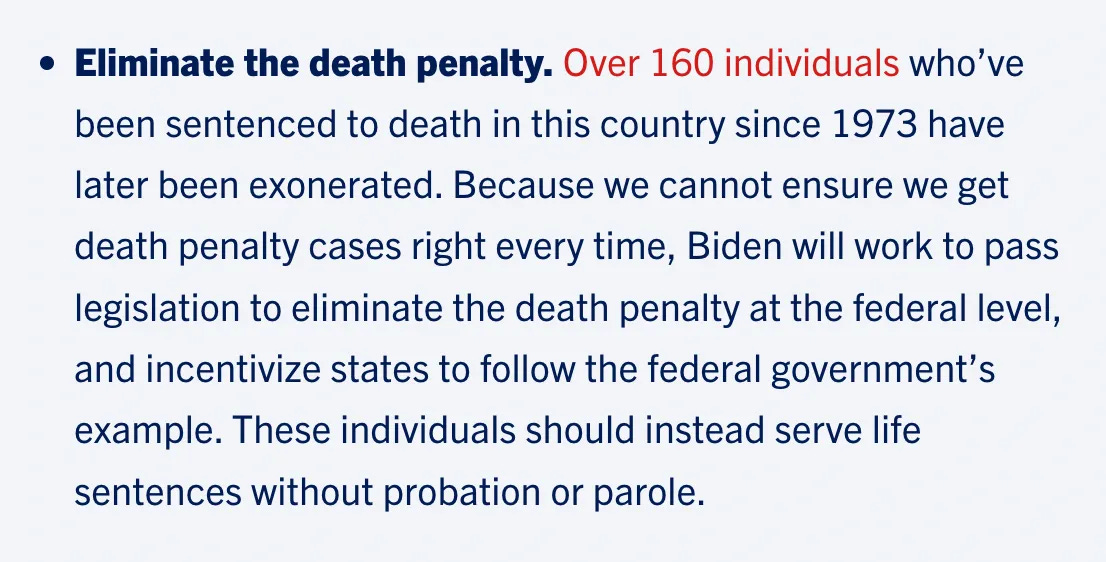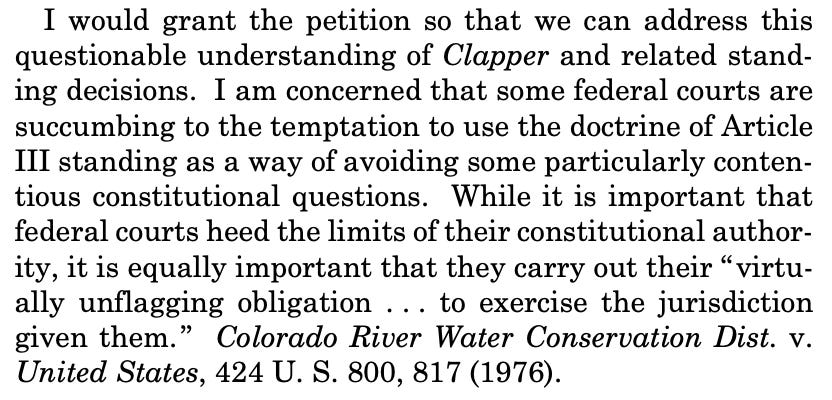SCOTUS sidesteps case over school gender identity policy — but Alito calls for action
Justice Alito wrote that the court should take steps that would bring more far-right cases to the justices. Also: More on the push for Biden to clear federal death row.
On Monday, the U.S. Supreme Court announced that it would not be taking up a case relating to a parental rights challenge to a Wisconsin school district’s policy of supporting students with questions about their gender identity.
Along with the order denying review, however, was a plea from Justice Sam Alito, joined by Justice Clarence Thomas, to consider allowing more cases into court — cases raising “contentious constitutional questions” despite featuring plaintiffs with only tangential connections to the policies or laws being challenged. Given the makeup of today’s court, it was a request that would overwhelmingly benefit far-right challenges like the one brought by Parents Protecting Our Children, UA, in the Wisconsin case.
Although the conservative parents’ group claimed in its Supreme Court filing that the policy of the Eu Claire Area School District is “to facilitate gender identity transitions at school and to keep this hidden from parents who would disagree that it is in their child’s best interest to change gender identity,“ none of the parents involved have a student affected by the policy and, in any event, the school district asserted that the group “grossly mischaracterizes” the policy.
Of note, the school district explained, “All Gender Support Plans are maintained in a student’s permanent pupil records file. … Even if a student does not want their parents to know about their gender identity issues or the existence of the Gender Support Plan, they are specifically advised that the Gender Support Plan is a pupil record that is always available to their parents and that it is ‘not a privileged document between the student and the school district.’”
The policy itself was not even before the Supreme Court. Instead, the case was — at this point — over whether Parents Protecting Our Children, UA, even has standing to bring the challenge. Standing is the requirement that a plaintiff have a legal injury that can be addressed by the court.
As the school district explained in opposing Supreme Court review, “Petitioner based its lawsuit on a claim that at some unknown point in the future one of its members’ children might identify as transgender, and if so, they might request gender support from the District, and then, further, they might also request that the District not immediately notify their parent of these facts.“
Notably, two Trump appointees on the U.S. Court of Appeals for the Seventh Circuit, along with a now-retired Clinton appointee, unanimously agreed in March, upholding a district court’s decision tossing the case on standing grounds.
Judge Michael Scudder, one of the Trump appointees on the Seventh Circuit panel, wrote in affirming the case’s dismissal, “Parents Protecting is clear that their members harbor genuine concerns about possible applications of the School District’s policy. Unless that policy operates to impose an injury or to create an imminent risk of injury, however—a worry that may never come to pass—the association’s concerns do not establish standing to sue and thus do not create a Case or Controversy.”
And yet, on Monday, the Supreme Court was one vote away from taking up the case.
Justices Clarence Thomas, Sam Alito, and Brett Kavanaugh voted to grant the group’s petition for review. It only takes four justices to grant certiorari and review a case.
Although Kavanaugh simply noted that he would have granted review, Alito wrote for himself and Thomas a brief missive dissenting from the denial.
More on that in a second, but, before we get into the dissent, Kavanaugh’s move is notable. Justices do not need to — and often don’t — share their votes on certiorari petitions like this one. It’s impossible to know why he did so here, but the effect is what I wrote above: Because he did so, even though he didn’t join Alito’s statement, he let it be known that the court was one vote away from taking the case — and that everyone else, including the other Republican appointees, voted against review.
As to Alito’s dissent, he appears to have just taken the conservative group’s claims at face value, ignoring the Seventh Circuit and district court rulings and the school district’s opposition to review.
“This case presents a question of great and growing national importance: whether a public school district violates parents’ ‘fundamental constitutional right to make decisions concerning the rearing of’ their children … when, without parental knowledge or consent, it encourages a student to transition to a new gender or assists in that process,” Alito wrote, quoting from a 2000 decision, Troxel v. Granville.
This is not at all surprising following his questioning in last week’s case over Tennessee’s ban on gender-affirming medical care for minors, or, well, knowing anything about Alito, who is a problem.
Alito, though, wasn’t only using this as an opportunity to spread anti-trans propaganda. Now that Trump has won re-election and Alito is confident a conservative majority will control the court for the next decade or longer, he also signaled a desire to reverse the court’s longstanding effort to restrict standing. The Seventh Circuit and district court relied heavily on a pivotal 2013 decision limiting standing, Clapper v. Amnesty International USA, to keep the parents group out of court.
Who wrote that 5-4 majority decision keeping the progressive group out of court in Clapper, you ask. It was none other than one Sam Alito. On Monday, though, in closing his dissent, he suggested that maybe this all has gotten a little out of hand:
Alito wrote on Monday, “I am concerned that some federal courts are succumbing to the temptation to use the doctrine of Article III standing as a way of avoiding some particularly contentious constitutional questions.”
In short, Alito wants more far-right lawsuits to be allowed to go forward.
Only Thomas — who joined Alito’s Clapper opinion — joined him on Monday. But, understand how precarious this all is. Kavanaugh voted to hear the case, which would have raised this question. With one more vote for certiorari, then, the case would have gone forward to the merits. Then, with the issue being forced, if just one of the two remaining Republican appointees joined the four, they could create a majority on the merits and make Alito’s dissent into law.
That day wasn’t today — but it’s also not as unfathomable as a two-vote dissent might suggest.
Biden urged to do what he can to end the federal death penalty

President Joe Biden pledged as a candidate for president to end the federal death penalty and encourage states to do the same.
Thus far, all that’s happened under his watch is a moratorium on federal executions and a review of the process — both ordered by Attorney General Merrick Garland. Along with that, though, the administration has defended existing death sentences, continued capital prosecutions initiated before Biden took office, and even brought at least one new capital prosecution — also done under Garland’s direction.
A similar moratorium had been in place in the Obama administration, but then the Trump administration took over, ended the moratorium, and carried out 13 executions.
With 40 people on federal death row currently, and Donald Trump set to return to office in 42 days, the circumstances could all repeat themselves.
Last time, Biden was vice president and had no real authority. As president, though, he can stop Trump from starting up the killing spree again. I’ve previously written about the need for Biden to empty the federal death row by granting commutations — sparing their lives with lifetime sentences. Biden’s pardoning of Hunter Biden shows he is not afraid to use his constitutional power, as I also wrote.
Lawmakers, also, have asked Biden to act.
On Monday, the Washington Post reported on a wide variety of groups and individuals sending letters urging Biden to take this action.
One letter from family members of murder victims struck me:
The death penalty does not prevent violence. It does not solve crime. It divides families when we need each other the most, polarizing us, telling us that only some murders are heinous, and creating more trauma for more families. It does not give solace to the family members of the 185,000 cold case homicide victims that have been left only with questions over the last 50 years, while countless law enforcement hours chase a handful of executions. It wastes many millions of dollars that could be better invested in programs that actually reduce crime and violence and that address the needs of families like ours.
We want a justice system that creates safety, healing, and accountability that repairs – one that is responsive to the needs of survivors and family members like us. By all these measures, the death penalty fails. This is why we believe it has no place in our society and should be ended.
Please use your clemency power to commute all current federal death sentences.
According to the Post, the White House is considering action — although it’s notable the sentence is attributed to the “White House” and not Biden specifically:
The White House has been listening to the arguments and discussing possibly taking steps to commute at least some federal death sentences, according to multiple people familiar with the internal conversations who spoke on the condition of anonymity to detail private and ongoing deliberations.
“No decision has been made, however, about the breadth or scope of such a possible move, including whether to do it at all or how many or which death row inmates might be included, the people said.“
Though vague and indeterminate, and though it should be all of the death sentences based on Biden’s own pledge, the Post’s reporting does at least suggest that the issue is not being completely ignored.
It is Biden, though, who ultimately has to act. He has 42 days to do so.







I am really hoping Biden will take the right and moral action to commute all of the federal death penalties. There is no downside to taking this action. I also hope I live to see the day when the death penalty is abolished nationwide. The statement from victim’s families sums up my feelings.
Thank you very much for providing access to Legal Dork. As a Senior, I am on a fixed income. It is very kind of you to understand that not everyone can afford a subscription.